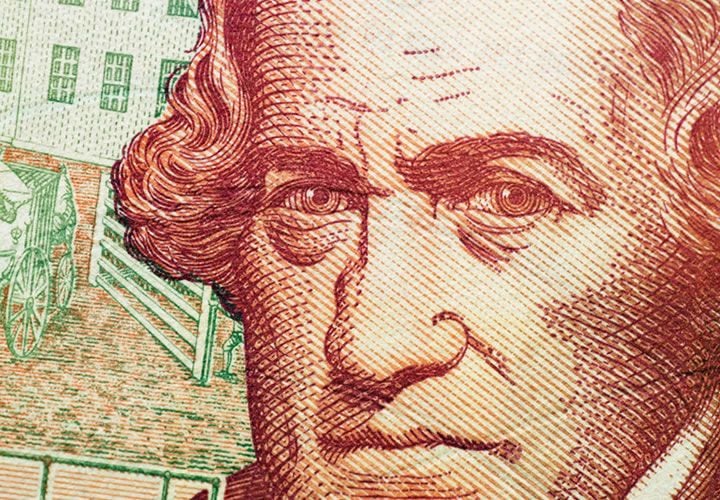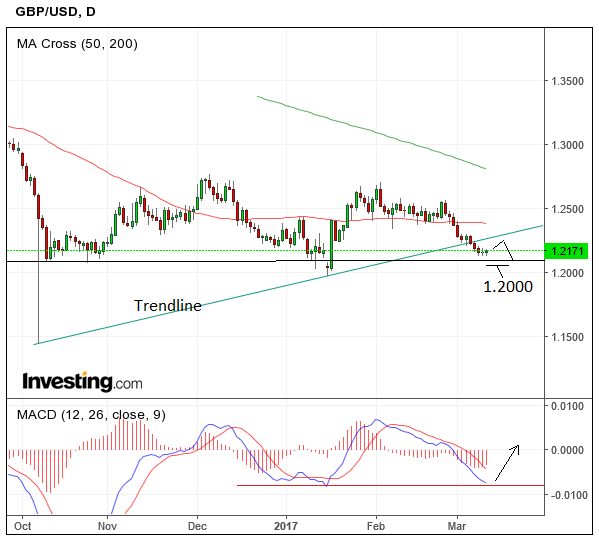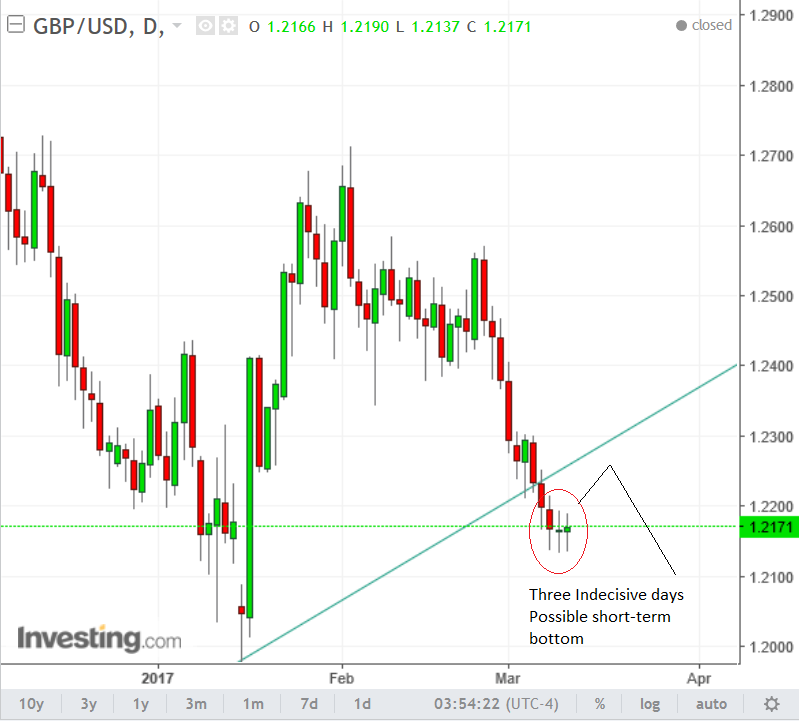A Correction Higher in the GBP/USD Exchange Rate Could be About to Begin

The British Pound starts the new week on the front-foot against the US Dollar with the GBP/USD exchange rate quoted at 1.2208.
We saw three indecisive days of trading action characterise the end of the previous week which is indicative of the Pound to Dollar exchange rate stalling in the middle of its short-term downtrend.
Pound Sterling had been running lower but a reversal in fortunes for the US Dollar on the final day of the week in the wake of the relase of US employment data has seen pressure ease temporarily.
This could indicate a correction higher is about to begin, leading to a temporary recovery in the exchange rate.
The MACD has fallen to the level of its previous trough which is a place where we see a possibility of it basing and rising.

The break below the trendline drawn from the October lows was a key bearish sign and suggests more bearish price-action is on the cards, however, the possibility of a correction means this extension could be delayed.
A major obstacle to further downside is also the S2 monthly pivot at 1.2118, and this would have to be breached for us to have confidence of the bear trend extending.
Therefore, we would want to see a clear break below the pivot, confirmed by a move below 1.2090 for conformation of such a move, with an initial target thereafter of 1.2000 – a key psychological level.

US Fed Decision Dominates this Week's Calendar
Dominating the week ahead is the Federal Reserve Open Market Committee (FOMC) meeting on Wednesday, March 15 at 18.00 GMT, and a press conference with Janet Yellen, the Fed Chair afterwards.
There is now a 100% - or close to – estimated chance the FOMC will decide to increase US interest rates by 0.25% to a new base lending rate of 1.00%.
Therefore, if they were to not raise rates expect the Dollar to drop like a stone.
Since the outcome is now beyond doubt and fully absorbed by current prices in the Dollar complex, traders will instead be focusing in what Janet Yellen says in her Press Conference about the possibilities of a June rate rise as this will be the next big question for markets.
The overall expectations for future policy from all FOMC voting members will also be illustrated by the Fed’s dot plot chart released in their 'projections' document.
The dot plot chart gives an indication of where Fed members see future interest rates - if the dots are raised higher this is indicative of a Fed that is looking to push rates up at a rate that is faster than they had previously anticipated.
Such an outcome is therefore positive for the Dollar.
Investors will also be paying a close attention to this as a possible indicator of appetite for June hike, as well as whether the Fed now expect to hike rates more than 3 times in 2017.
The nuances will be important - watch Yellen's tone and watch her stance on how the Fed should proceed in line with President Donald Trump's intentions on fiscal policy.
Wednesday is also a key day for the Dollar on the hard data front as it will witness the release of February Inflation data.
Core CPI is forecast to rise by 2.2% from the previous year.
Headline CPI is expected to come out at 0.1% from 0.6% in the previous month of January and Core CPI, on a monthly basis, is expected to show a 0.2% rise.
The CPI data is released at 12.30, prior to the FOMC, and whilst no surprises are foreseen, a downside shock is one of the last remaining risks to the FOMC not raising rates, however, it would have to be a deep plunge to impact and that is highly improbable.
Core Retail Sales, which means without volatile fuel and food sales, is also released on Wednesday at 12.30, and is expected to rise by 0.2% in February from a higher 0.6% in January.
Thursday March 16 sees the release of Housing data, starting with Building Permits at 12.30, which are forecast to fall to 1.26m from 1.29m in February.
Housing Starts, out at the same time, are expected to grow to 1.26m from 1.248m previously.
Commentators are waiting for signs from the housing market that rising interest rates are starting to reign in mortgage borrowing and slow the housing market down, but so far this has not yet happened.
A slow-down in housing would be a negative indicator for the economy as it is a widely held market maxim that the economy “follows Housing”.
Bank of England, Employment Data Ahead for the Pound
The meeting of the Bank of England (BoE) on March 16 at 12.00 GMT is the highlight of the week ahead for Sterling.
Although no-change in policy is expected, the minutes which are released at the same time as the decision, will show how members deliberated on monetary policy issues.
Whilst some commentators had seen the BoE moving towards a tighter monetary policy stance, this has probably changed since the spring Budget statement.
There is now a heightened possibility that the BoE will have to keep monetary policy expansive and interest rates low due the Chancellor’s fiscally tight budget, in which he gave away only 3bn in stimulus, according to Jonathan Loynes at Capital Economics.
“Fiscal policy is still set to provide a significant drag on GDP growth over the next few years – very similar to that planned in the Autumn Statement. As such, the onus will remain on monetary policy to support the economy,” says Loynes in a note seen by Pound Sterling Live.
Such a policy will keep the pressure on sterling, particularly versus the Dollar where interest rates are contrastingly set to rise.
Indeed, in a separate note from Capital Economics, authored by Danial Wishart, he actually predicts that Cable will fall further on diverging US/UK central bank policies.
On the ‘hard’ data front, the main release for Sterling is labour market data on Wednesday March 15, although the unemployment rate is not expected to change from the current 4.8%.
Average Earnings are forecast to slip to 2.4% from 2.6% previously and the Claimant Count to go down by 5.0k from -42.5k previously.





